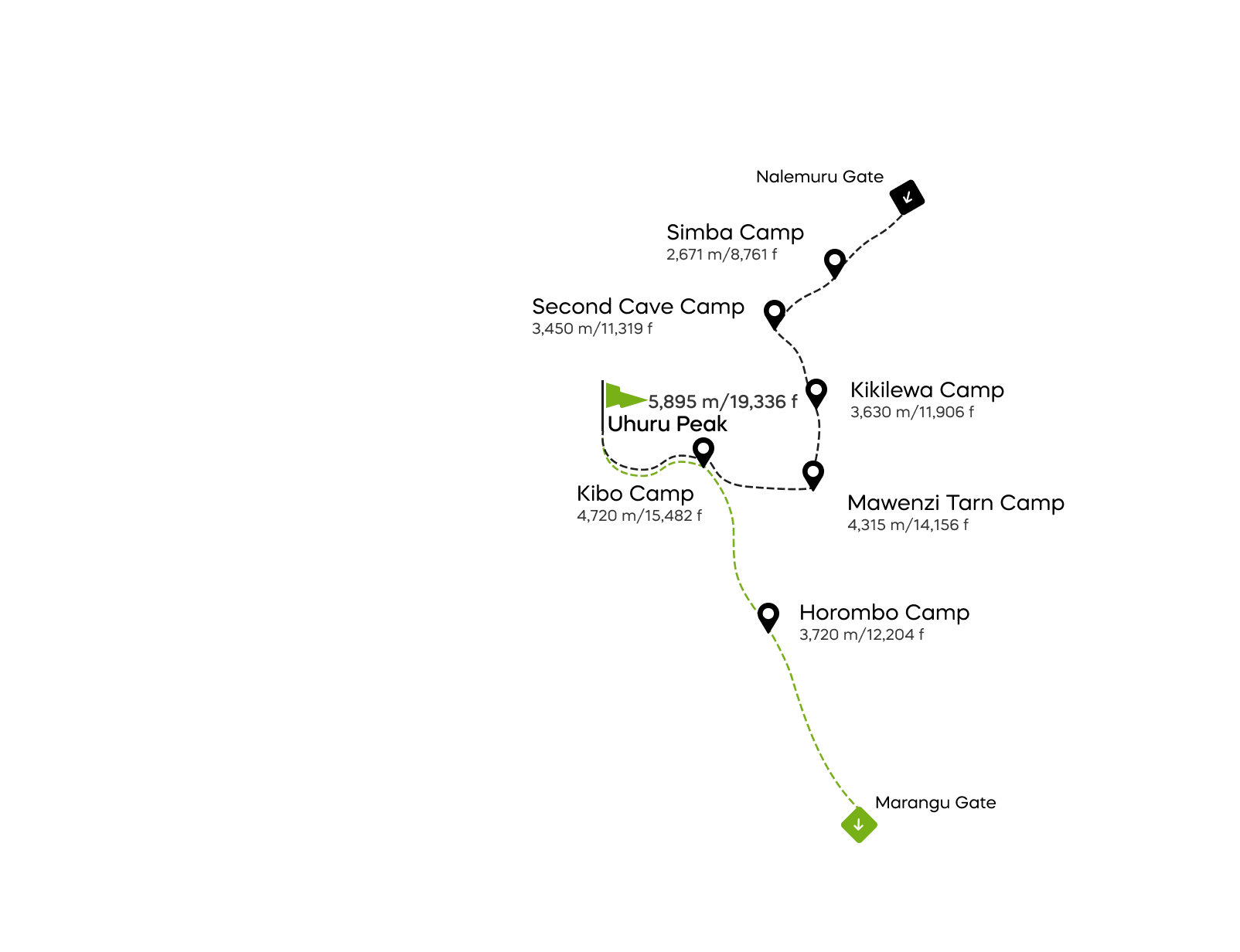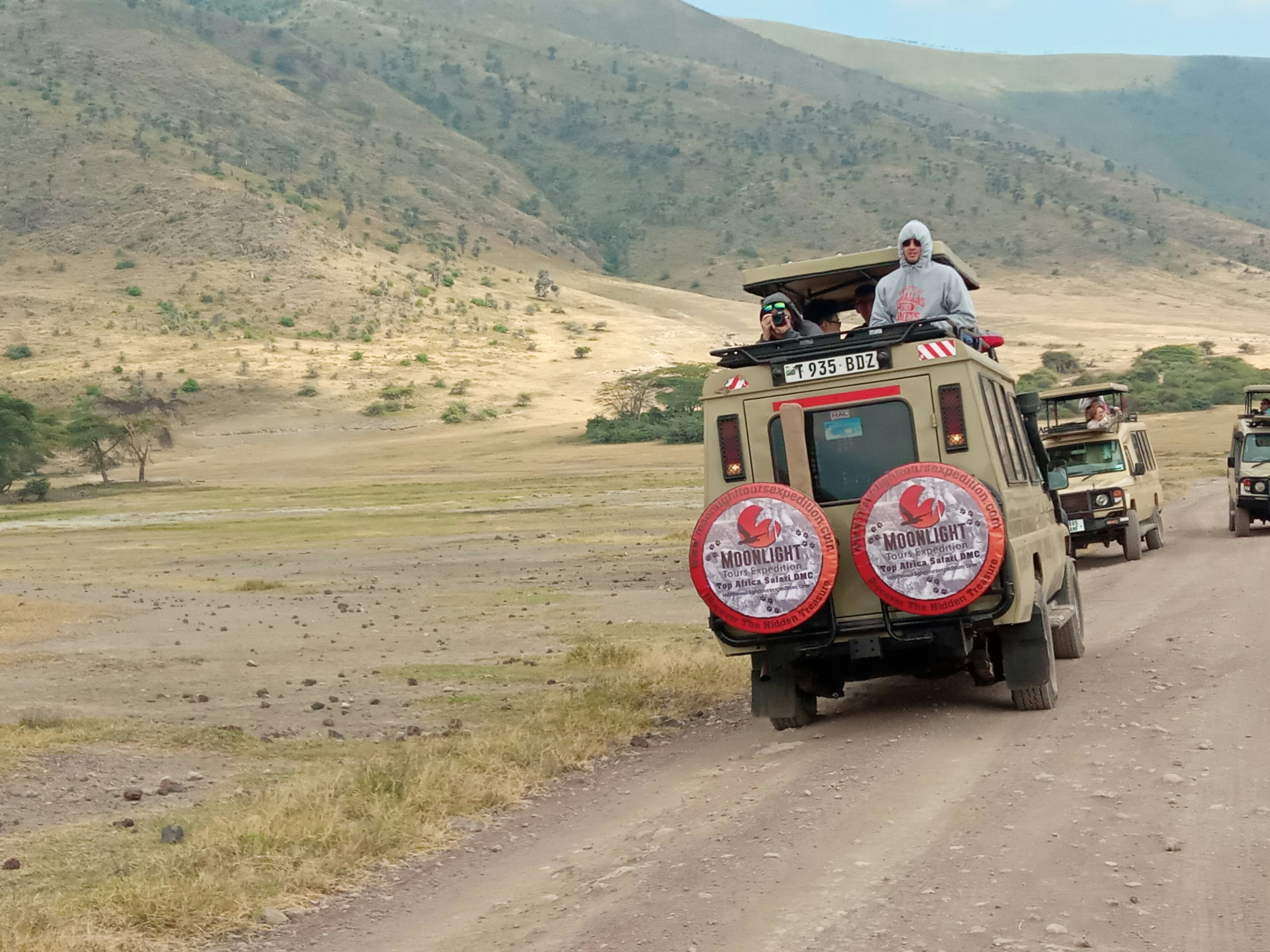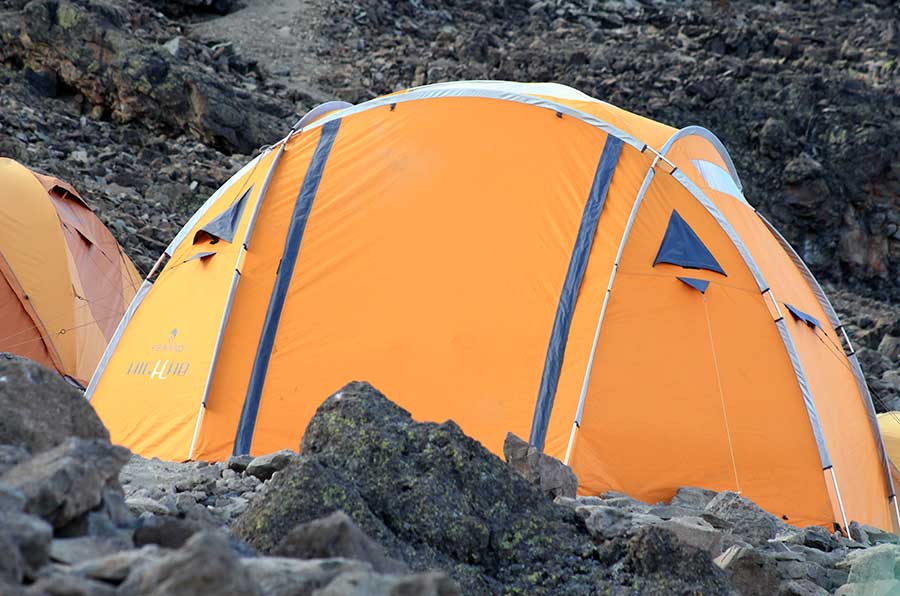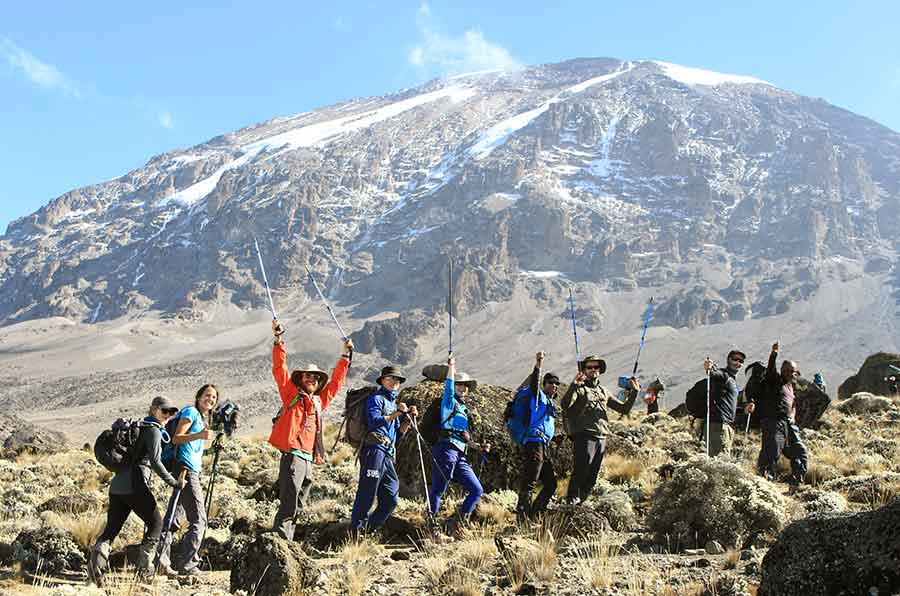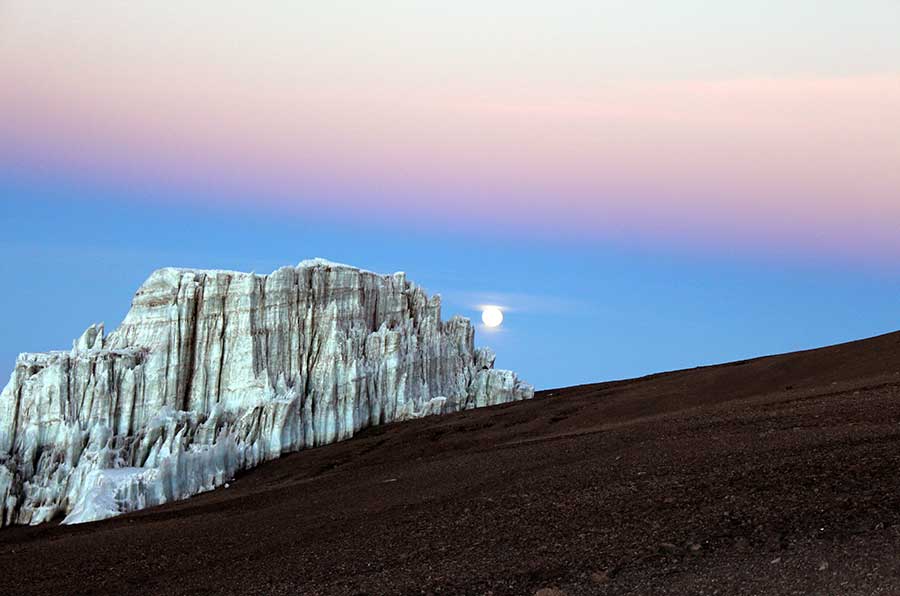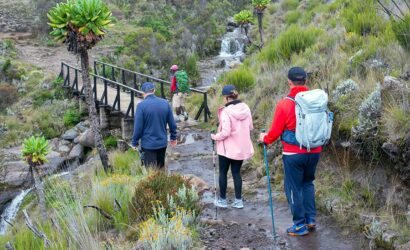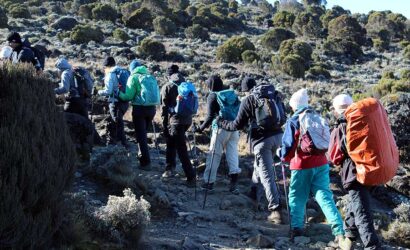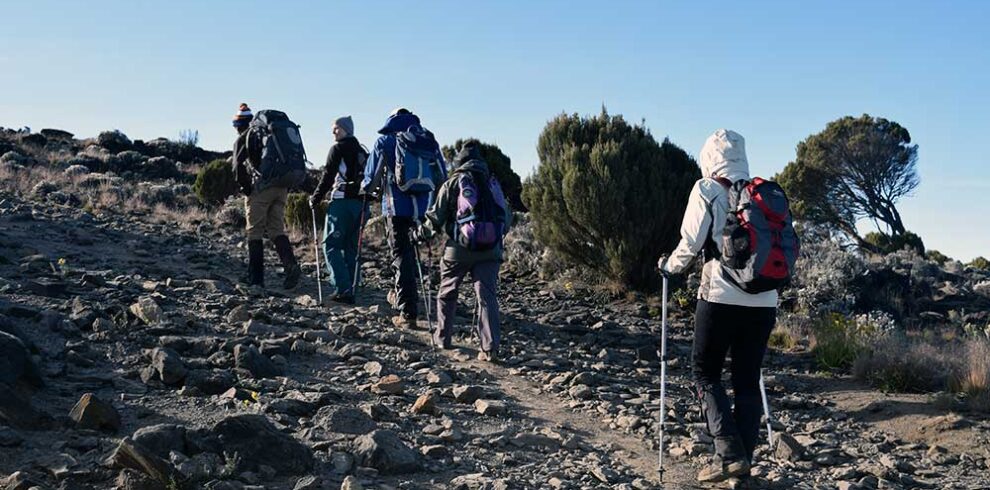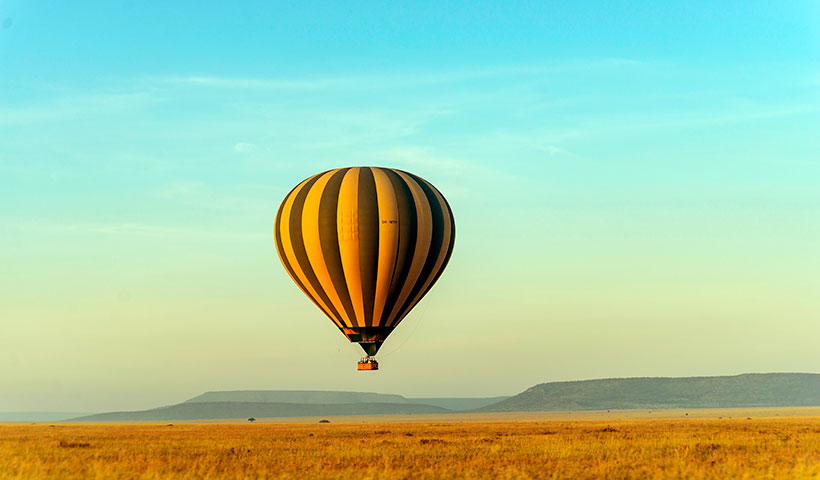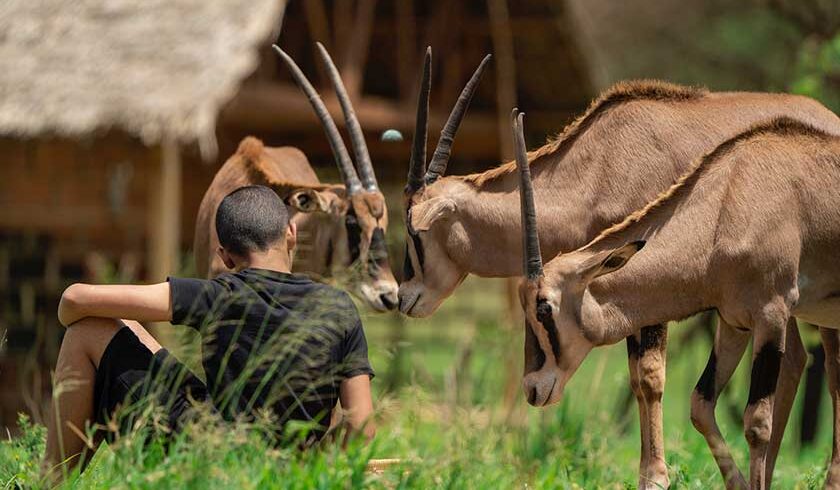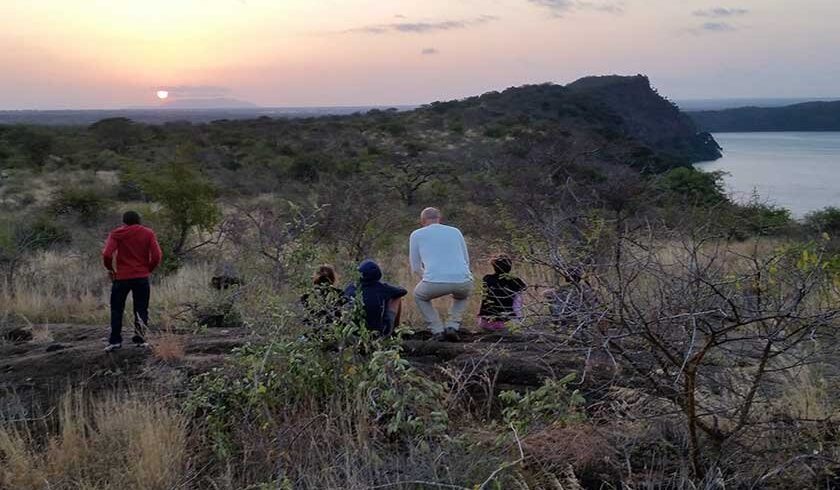Overview
The Rongai Route is one of the easiest routes, and the success rate is very high.
The route starts on the north side of the mountain just south of the Kenyan border, and is one of the least traveled routes. The descent is down the Marangu Route on the south side of the mountain, so climbers see the mountain from many view points.
The drive to the trail head takes about 3 hours from Moshi through many villages and coffee plantations, including a stop to register climbing permits at Marangu.
The Rongai Route can also be accessed from Amboseli National Park in Kenya. Allow 2 hours, including border crossing. We will need copies of passports ahead of time.
Tour Highlights
- Departure and Return Place: Moshi Town to Rongai Gate and then back to Kilimanjaro International Airport (Google Map)
- Departure Time: Please be ready by 8:15 AM for a prompt departure at 9:30 AM.
- Return Time: Approximately 10:30 AM on the last day.
- Dress Code: Casual. Comfortable athletic clothing, hiking shoes, hat, cold weather jacket, gloves, pants, and spare clothing.
- Accommodation: Two nights of accommodations based on Bed and Breakfast at 3 stars hotel (upgrades on request).
- Customizations: Can be customized upon request, to meet traveller’s needs
- Extensions: Trip Extensions are available on request.
- Trip Availability: All year round.
Itinerary
If you have opted for the optional airport transfers, we will pick you up from Kilimanjaro Airport or Arusha airport and transfer you to your hotel in Moshi.
Pre-trek briefing at your Moshi hotel. You should be planning to arrive atleast one day before the start of the trek. Today we will spend in having a pre-trek briefing. We will also review your equipment and rent any equipment which is needed.
Drive to the attractive wooden village of Nale Moru (about 2 hours including a stop to get permits at Marangu). After signing in and preparing the porters, you will begin the hike on a wide path that winds through fields of maize and potatoes before entering pine forest. The track then starts to climb consistently but gently through attractive forest that shelters a variety of wildlife. The forest begins to thin out and the first camp is at the edge of the moorland zone with extensive views over the Kenyan plains.
Elevation: 2000m/6560ft to 2650m/8700ft
Distance: 6km/4mi
Hiking Time: 3-4 hours
Habitat: Montane Forest
Meals: Lunch and Dinner
The morning hike is a steady ascent up to the Second Cave with superb views of Kibo and the Eastern ice fields on the crater rim.
Elevation: 2650m/8700ft to 3450m/11,300ft
Distance: 6km/4mi
Walking Time: 3-4 hours
Habitat: Moorland
Meals: Breakfast, Lunch and Dinner
Head out across the moorland on a smaller path towards the jagged peaks of Mawenzi. The campsite is in a sheltered valley with giant Senecios nearby.
Elevation: 3450m/11,300ft to 3600m/11,800ft
Distance: 9km/5mi
Walking Time: 2-3 hours
Habitat: Semi-desert
Meals: Breakfast, Lunch and Dinner
A short but steep climb up grassy slopes is rewarded by superb views. Leave the vegetation behind shortly before reaching the next camp at Mawenzi Tarn, spectacularly situated in a cirque directly beneath the towering spires of Mawenzi. The afternoon will be free to rest or explore the surrounding area as an aid to acclimatization.
Elevation: 3600m/11,800ft to 4330m/14,200ft
Distance: 6km/4mi
Walking Time: 3-4 hours
Habitat: Semi-desert
Meals: Breakfast, Lunch and Dinner
Cross the lunar desert of the ‘Saddle’ between Mawenzi and Kibo to reach Kibo campsite at the bottom of the Kibo crater wall. The remainder of the day is spent resting in preparation for the final ascent very early.
Elevation: 4330m/14,200ft to 4750m/15,600ft
Distance: 9km/5mi
Hiking Time: 4-5 hours
Habitat: Alpine Desert
Meals: Breakfast, Lunch and Dinner
Very early in the morning (midnight to 2am), commence the climb to the summit on steep and heavy scree or snow up to Gilman’s Point located on the crater rim (elev 5700m/18,700ft). Continuing, we now ascend to Uhuru Peak, which is the highest point in Africa. There are unbelievable views at every turn. Have your picture taken at the summit to show your friends and family. From here we descend, stopping for lunch and a rest at Kibo before continuing on to the Horombo encampment.
The beginning of this climb is done in the dark and requires headlamps or flashlights. It will be very cold until you start descending, so you will need all of your warm layers. This is by far the most difficult part of the trek with many switchbacks. Going slowly “pole pole” and an optimistic attitude will get you there!
Elevation: 4700m/15,500ft to 5895m/19,340ft
Down to 3700m/12,200ft
Distance: 6km/4mi up / 15km/9mi down
Hiking Time: 6-8 hours up / 6-8 hours down
Habitat: Alpine Desert
Meals: Breakfast, Lunch and Dinner
After breakfast, a steady descent takes us down through moorland to the Mandara Hut. Continue descending through lush forest path to the National Park gate at Marangu. At lower elevations, it can be wet and muddy. Gaiters and trekking poles will help. Shorts and t-shirts will probably be plenty to wear (keep rain gear and warmer clothing handy).
Tulia Essence vehicle will meet you at Marangu gate to drive you back to your hotel in Moshi (about 1 hour).
Elevation: 3700m/12,200ft to 1700m/5500ft
Distance: 20km/12.5mi
Hiking Time: 4-5 hours
Habitat: Forest
Meals: Breakfast
Includes/Excludes
Includes
- Quality Mess tents with a table and chairs
- Kilimanjaro summit certificate
- Guides, Porters, Cook salaries and park fees
- Large portions of fresh, healthy, nutritious food
- Camping or Hut fees (part of park fees)
- Emergency Oxygen Cylinder
- VAT (18% charged by the Government)
- All meals while on the Mountain
- Rescue fees (part of park fees)
- All transfers to the mountain and back to your Moshi hotel
- Sleeping Mattress
- Conservation fees (part of park fees)
- Professional, experienced mountain guides
- Clean, purified drinking water
- Quality, waterproof, four-season mountain sleeping tent (on twin sharing basis)
Excludes
- Liquors, beers and bottled beverages
- Hotel (available as an optional addon)
- Personal Expenses (e.g. laundry, telephone, beverages, etc.)
- Tanzania Visa
- Transfers (available as an optional addon)
- Meals not listed in the itinerary
- Surcharge for online payment of advance and balance (5% on each payment)
- Tips and gratuities
- International and domestic flights
- Personal trekking equipment such as sleeping bags, hiking boots, clothes, etc (available for renting)
- Travel insurance
FAQs
Mount Kilimanjaro can be climbed anytime throughout the year. Most travelers prefer climbing during the dry seasons: December to March, June to October. Many consider the best months to climb Kilimanjaro to be January, February, and September.
We are. We are not agents for anybody, but run the treks ourselves through our own Tanzanian company. So you can rest assured that whoever you speak to in our company has climbed Kilimanjaro – and probably many times.
There are at least six routes to the top, Uhuru peak. You will hike between 53 and 73km depending on which route you choose. The shortest and toughest is the 5-day Umbwe route. Allowing extra days will help you to acclimatize better and improve your chances of reaching the summit. The easiest and most popular route is Marangu (which can be done in five), but we use six days for this route.
None, but previous hiking or climbing experience will help. You need to be fit and healthy and have a good pair of worn-in hiking boots. The fitter you are the more you are likely to enjoy it.
Your Kilimanjaro dream climb is entirely your own to design. We will work with you to customize exactly the triumphant Tanzanian mountainous quest experience you want. You go with the people you choose. You leave on whatever day you wish. You decide on your preferred route option, pace, and the number of days you will take.
On most routes, you’ll trek 4-7 hours most days. On certain routes you’ll trek as many as 10-15 hours on the longest days.
Prior to the climb, you’ll enjoy an acclimatization day with wildlife viewing and nature walks. Trekking through the rain forest, you’re likely to spot black-and-white Colobus monkeys, tropical birds and more.
Highly-trained chefs prepare three hot nutritious meals daily, as well as trail snacks and afternoon tea each day. You’ll eat all your meals in a solar-lit dining tent with your fellow trekkers and head guide. Delicious vegetarian, vegan, gluten-free and other specialty meals can be provided (with advance request). We’re happy to send you a sample menu—just ask!
Your mountain camps are set up and broken down each day by expert camp porters. You’ll stay in double occupancy all-weather tents with full-ground pads to keep you and your gear dry. Private toilet tents, solar-lit dining tents with tables and chairs, and basins of hot water for washing are provided in every camp. Grand Traverse treks include upgraded solar-lit walk-in-height sleeping tents with mountaineering beds and mattresses for additional comfort.
We are. We are not agents for anybody, but run the treks ourselves through our own registered Tanzanian local company.
Yes, we do arrange this. Please send your request to Safari.
You will need a passport that is valid at least six months beyond your dates of travel with an entry or re-entry visa, duly endorsed.
The mountain is in Tanzania, East Africa, about 350km from the equator. The nearest towns are Moshi and Arusha.
Mount Kilimanjaro is the highest freestanding mountain in the world and the highest mountain in Africa. Its highest point is Uhuru Peak on the Kibo crater at 5895m above sea level.
Yes, it is expected and much appreciated. The amount depends on the number of days, but can range from $150 and $350 per hiker. Tips are pooled and shared amongst the crew.
Rongai Map
